#wireless audio module
Explore tagged Tumblr posts
Text
3KM Transmission Distance | Low Latency | 48K Sampling Audio Transmission Module - SA356 High Power Transmission Module
In wireless audio applications, long-distance audio transmission is widely needed in many fields, such as large conference systems, public broadcasting, outdoor events, and music performances. To meet these demands, audio transmission modules must have several key features, including long-distance transmission capability, high sound quality, low latency, stability, and anti-interference ability. In order to solve the problem of ultra-long-distance audio transmission, NiceRF has launched a high-power transceiver module solution for audio transmission.
For the SA326 series module, SA356-TX is a 5W transmission module, which can be paired with the SA326-RX receiver module. The SA356-TX is an amplified 5W version of the SA316-TX application board. It starts working as soon as it is powered on, and users can directly set the module's frequency, volume, and other parameters using PC software, significantly simplifying the development process. This product is widely used in scenarios requiring high audio quality.
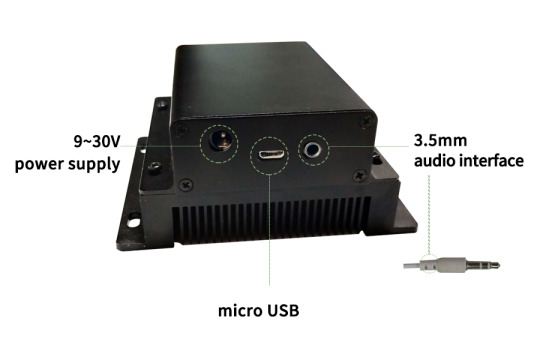
Advantages of Audio Transceiver Module
1.Long-Distance Transmission: transmitting range 3000 meters in open area
Transmission distance is a crucial parameter for long-distance audio transmission. The SA356 module, equipped with a 5W transmission power, can achieve a transmission distance of 3000 meters in open, unobstructed environments. This makes it highly suitable for applications requiring wide coverage, such as large outdoor events and public square broadcasting.
2.Sound Quality Requirements: signal-to-noise ratio is 96 dB , the frequency response range from 20 Hz to 20 kHz.
High-fidelity audio transmission is essential for long-distance audio applications. The SA356 module has a high signal-to-noise ratio 96 dB, which can significantly reduce noise during transmission and ensuring purity of the audio signal. Additionally, its frequency response range from 20 Hz to 20 kHz covers the entire audible spectrum, from low bass to high treble, ensuring comprehensive transmission fidelity. This is particularly crucial for scenarios such as music performances and conference speeches that require high-quality audio, delivering an exceptional auditory experience.
Low Latency: Latency is less than 3ms
In real-time audio applications, latency is a critical factor, whether for live performances or video conferences where audio-video synchronization is crucial. The SA356 module maintains latency from microphone input to audio output within 3 milliseconds, almost negligible. This ensures perfect synchronization between sound and visuals, enhancing user experience and making it highly suitable for real-time applications.
Stability and Anti-Interference Capability: The module utilizes digital modulation scheme pi/4 DQPSK, occupying a bandwidth of less than 300 KHz.
In long-distance audio transmission, the stability of the signal and its resistance to interference directly impact audio quality. The SA356 module utilizes pi/4 DQPSK digital modulation, known for its strong anti-interference capabilities and transmission stability. Additionally, it occupies a bandwidth of less than 300 KHz, greatly enhancing spectral efficiency and reducing the likelihood of interference. This allows the SA356 module to maintain stable audio transmission even in complex wireless environments.
5.Transmission Rate and Sampling Rate:Transmission Rate 204.8 Ksps, Sampling Rate 48 KHz
To achieve high-quality audio transmission, transmission rate and sampling rate are crucial parameters to be considered. The SA356's 204.8 Ksps transmission rate and 48 KHz sampling rate ensure high fidelity and clarity of audio signals during transmission. A high sampling rate captures more sound details, providing a richer and more realistic audio experience, meeting the requirements for professional audio transmission.
SA356 Module Features
UHF frequency band:500 MHz
The transmission distance is 3000 meters in the open area
Audio signal to noise ratio: 96 dB
Frequency response: 20 Hz-20 KHz
The delay from microphone input to audio output is less than 3ms
Digital modulation method: pi/4 DQPSK
Occupied bandwidth: <300 KHz
Transmission rate: 8 Ksps
Sampling rate: 48 KHz
Electrical Characteristics
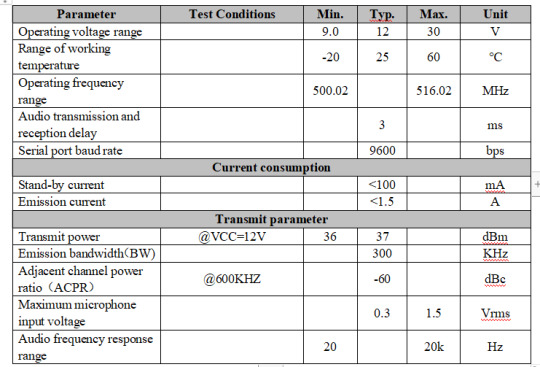
In summary, the SA356 audio module is very suitable for long-distance audio transmission in terms of transmission distance and sound quality. It is suitable for wireless microphones, large-scale outdoor activities, public broadcasting and other systems
For details, please click:https://www.nicerf.com/products/ Or click:https://nicerf.en.alibaba.com/productlist.html?spm=a2700.shop_index.88.4.1fec2b006JKUsd For consultation, please contact NiceRF (Email: [email protected]).
0 notes
Text
Wireless rf frequency, digital audio mixer circuit programming, RFID capability
NT3H2111 Series 3.6 V 13.56 MHz Surface Mount RFID Transponder - XQFN-8
#Wireless & RF#RF Modules & Solutions RFID#NT3H2111W0FHKH#NXP#Wireless rf frequency#digital audio mixer circuit programming#RFID capability#rf control systems#Wireless detectors circuit#remote control#Digital rf modulator#demodulator
1 note
·
View note
Note
SORRY IF THIS HAS BEEN ANSWERED BEFORE! BUT! do the androids ever need to charge? or do they purely run on thirium? like are they solar powered? do they have wireless charging pads they sleep under? like how does this work /gq
NO THATS A VALID QUESTION!! Honestly the actual dbh wiki is an unprecedented amount of unhelpful so I have to make everything up myself /silly
Afaik, thirium is only ever described as the fluid required to power the androids’ “biocomponents,” aka organs, aka individual modules that each power, like... A function. For example, there’s an audio biocomponent, the eyes are biocomponents, the thirium pump and thirium pump regulator are both biocomponents, etc etc etc. So technically, as long as an android has thirium, their biocomponents should be able to work just fine? But it seems improbable to me that an android could just work and work and work and never get “tired” (less effective, worn down over time, fried, etc). So in dbhc, the way the androids were first designed by Xisuma meant that they could only work for so long before they needed to go into a Low Power Mode of some sort, aka to rest (so their circuits and insides don’t fry from overuse).
Later, sometime late s8 or early s9, xisuma and doc tweak the androids’ OS so that Low Power Mode works more or less like sleeping (as an option to androids who want more of a human experience). Instead of the androids needing to sit/stand somewhere and be sort of inoperable/limited capability for a few hours, an android will start getting “sleepy” or low-inefficiency/sluggish/etc after a certain amount of time and then require proper rest (I’m sure that x and doc time it so that androids are running on a clock similar to human bodies—aka, active for about 12-16 hours a day, needing rest for 6-8 hours, etc). While they can’t necessarily control the when the “sleepiness” comes on (such as when they’ve been working harder/running hotter one day and need rest sooner), I think I imagine that the androids do decide when to trigger or start sleep procedure/sleep mode/low power mode or whatever.
So, they don’t need to ���charge” per se, but they definitely need rest! Giving them a rest period also makes Impulse’s specialty more meaningful, since he was designed to be able to work for longer periods of time without rest/carry heavier loads :]
159 notes
·
View notes
Text
Alright RAM and headset have been ordered. They won't get here in time for this weekend's game of Enshrouded but next weekend should be good.
I don't know a whole lot about RAM. I ended up getting the Corsair 64gb modules. It has 3600mhz. I'm not sure how great that is for DDR4 but it's faster than the cheaper memory sticks that were 3200. I see DDR5 is up to 6000mhz but that requires a new motherboard.
As for the headset it has 3 input modes. There's a bluetooth option which I'm going to avoid since I'm sure that's what's causing my current audio problems. There's a 2.4ghz USB dongle for non-bluetooth wireless. Finally if all else fails there's an option to use an AUX cable.
My next weak point in the system is my video card. I have a GTX 1660TI with 6gb of V-RAM. Since I don't care about ray-tracing and I hardly ever play any new games it shouldn't need to be replaced anytime soon.
5 notes
·
View notes
Text
This small USB Bluetooth Mp3 Module can be used in home theater systems, portable speakers, audio, cars and furniture. It can support USB/SD-card/Blue tooth/ FM/ AUX switch. Operates at 3.6-7.2V and has push-buttons for ease of use.

Features:
Operating Voltage is 3.6V-7.2V
Support MP3 / WMA / WAV format music.
Support Resume function.
Support FAT32, FAT16 file system.
Support BT music and BT call function.
Support USB / SD-card switch/ FM(87.5MHz-108 MHz)/MP3/AUX function.
Size: 3.8*3.6*1.0 cm
4 notes
·
View notes
Text
Chord Electronics Summer Promo - Mojo2 and Poly!

Hi Everyone,
Just a quick blog to say that Chord Electronics will be running a Sunshine promotion from June 12th to August 31st 2023 on both Mojo2 and Poly! For only £395 each you can own a multi award winning British designed and made Chord Electronics Mojo2 headphone/Hifi Dac or a Poly streamer that can be used both in the home or on the move - or both for £790!
MOJO 2 Portable DAC/headphone amplifier
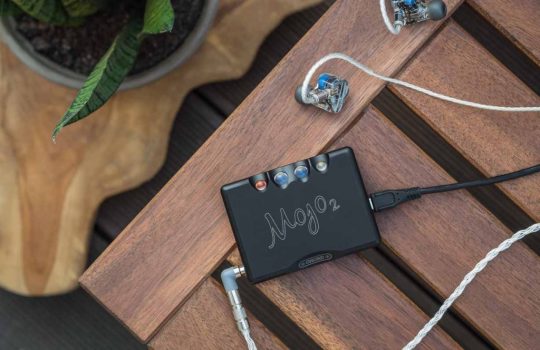
The British designed, engineered and built Mojo 2 is the most advanced portable DAC and headphone amplifier in the world. Distinctly different from all other devices, the What Hi-Fi? Product of the Year-winning Mojo 2 uses proprietary British digital audio technology perfected over more than two decades, coupled to a powerful ‘FPGA’ processor. The result is class-leading sound quality both on the move or at home, with the power to effortlessly drive any headphones. For music just as the artist intended, Mojo 2 brings you closer to the music than any other portable.
UNIQUE FPGA TECHNOLOGY
For more than 25 years, Chord Electronics has exclusively used powerful programmable (FPGA) circuits with custom coding to provide the most advanced digital-to-analogue conversion performance in the world. With digital audio technologies perfected over two decades, Mojo 2 contains more digital audio know-how than any other small DAC, resulting in unrivalled sound quality, all backed by peerless technical measurements from the lab.
COMPATIBLE WITH POLY FOR STREAMING
Completely compatible with our wireless streamer/player module Poly, for wireless streaming, control and playback
POLY Music streamer/player for Mojo 2/Mojo
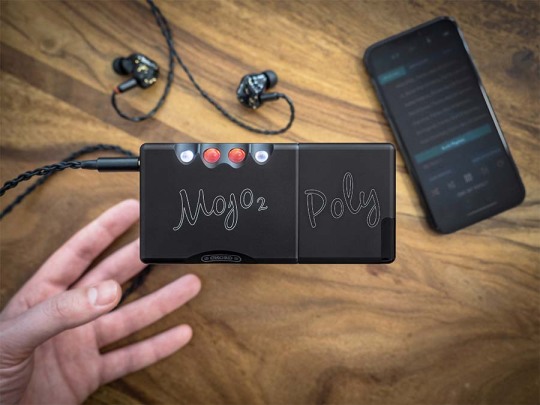
Poly is a revolutionary music streamer, the first of its kind in the world. When partnered with Mojo 2/Mojo, it enables music streamed from a range of wirelessly connected devices to be enjoyed in the best possible sound quality, whether at home or on the go. Poly is also a music player: its unlimited-capacity Micro SD card slot can house huge libraries and liberate storage on smart devices. Full smartphone control using everyday apps enables effortless music playback whether streaming or playing music from the Micro SD.
Poly directly connects to Mojo 2/Mojo’s award-winning audio processing (DAC) technology dramatically improving the audio quality of streamed music. Its advanced design enables everyday devices, including Android and Apple smartphones/tablets, to become portable ‘hi-fi-quality’ digital audio players: the smartphone becomes the controller, with Poly and Mojo 2/Mojo doing the high-level audio processing.
Poly can also be used with computers and laptops, plus it can access networked audio stored on NAS drives using popular DLNA apps. Playback is via Mojo 2/Mojo’s twin headphone outputs, plus home and in-car audio systems with auxiliary (AUX) inputs can also benefit from the improved sound quality.
Poly connects to Wi-Fi networks, including mobile hotspots when on the go, and remembers multiple networks with its auto-connect functionality. It also benefits from Bluetooth® wireless technology, AirPlay and DLNA connectivity, offering uninterrupted music streaming when transitioning from indoors to outdoors. Poly also features its own hotspot mode, enabling a connection where devices, networks or countries do not facilitate tethering. Its rechargeable LiPo batteries offer up to nine hours of playback from a four-hour charge using the device’s fast-charging USB circuit; both Poly and Mojo 2/Mojo can be charged simultaneously.
Poly is high-resolution audio-compatible, with support for the latest studio-quality files; PCM data up to 768kHz resolution and DSD64 to DSD256 (Quad-DSD). Supported file types include ACC, WAV, FLAC, AIFF, OGG VORBIS, ALAC, WMA and MP3.
Please don’t hesitate to contact HFL if you have any questions or require anything else 👍
https://hifilounge.co.uk/product-category/brands/chord-electronics/mojo-2/
All the best,
Billy

2 notes
·
View notes
Text
Price: [price_with_discount] (as of [price_update_date] - Details) [ad_1] Product Description Microware 2.4/5G WiFi HD Wireless HDMI Extender Video Audio AV Sender Transmitter Receiver Introduction The HDMI transmitter uses standard Ethernet TCP/IP protocol to transmit high-definition audio and video signals through wireless WIFI - 1 - signals, enabling point-to-point applications and many-to-one applications. The device has excellent image processing and transmission capabilities, making signal transmission more smooth and stable, and is a cost-effective way to wirelessly extend HDMI signals HDMI transmitter adopts standard Ethernet TCP/IP protocol and transmits high-definition audio and video signals through wireless WIFI signal. It can realize point-to-point application, multi-to-one application. The device has excellent image processing and transmission capabilities, which makes the signal transmission more smooth and stable. It is an economical and efficient wireless extension method for HDMI signals. This HDMI wireless extender uses a 5G wireless module, which transmits high-definition audio and video signals through the H.264 compression coding standard. It can transmit up to 50 meters in an open environment. The device has image processing and transmission capabilities, making signal transmission smoother and more stable. It is a cost-effective way to wireless extender HDMI signals. It is widely used in office presentations, lectures, education, conference halls, home entertainment, etc Feature HDMI video and audio signals are transmitted through built-in wireless WIFI. The farthest transmission in the open environment is 20 meters, and the farthest transmission in the partition wall is 10 meters. The highest resolution of HD video signal can reach 1920*1080P 60Hz. Compatible with HDMI 1.3. Support WIFI automatic link. Compression and decompression of videos using international standard H.264 format can effectively improve transmission efficiency and ensure smooth playback. Compliance with HDCP 1.2 Standard-High Bandwidth Digital Content Protection Technology. Ability to automatically identify and configure various display modes. Built-in automatic equalization system, smooth, clear and stable picture. Built-in ESD electrostatic protection circuit, all-round protection system security. Easy to install, Plug and Play, no need to set up. Up to 150 feet / 50 meters range, providing 5G high-speed wireless transmission Built-in 5G high-speed module and 5G high-power antenna, transmission distance up to 150 feet / 50 meters, suitable for large meeting rooms and large living rooms. Note: 1. Work through the wall can only support less than 10 meter 2. Only one set/pair can be used in the same environment! Otherwise it will affect the signal transmission and even cannot be used) Feature: 1. The HDMI transmitter uses standard Ethernet TCP/IP protocol to transmit high-definition audio and video signals through wireless WIFI signals, enabling point-to-point applications and many-to-one applications. 2. The device has excellent image processing and transmission capabilities, making signal transmission more smooth and stable, and is a cost-effective way to wirelessly extend HDMI signals.
3. In the open environment, the farthest transmission is 50 meters. If there is a partition wall, the maximum transmission is 10 meters. 4. High-definition video signal resolution up to 1920 x 1080P@60Hz. 5. Compatible with HDMI 1.3 and HDCP 1.2 compliant – high bandwidth digital content protection technology. 6. Easy to install, plug and play, no need to set up. Built-in automatic equalization system, the picture is smooth, clear and stable. Suitable for laptop, set-top box or DVD This product uses H.264 encoding technology to support HD picture transmission from HDMI source to a TV or projector, and the received image is clear and stable. You can enjoy video and audio at home or in the office. (Note: The sharpness of the received image is slightly lower than that of the source image, and there is a delay of 0.2s.) Connection & operation: Install the TX, RX antenna and ensure good contact. Connect the HDMI signal source to the HDMI wireless transmitter sender Connect the HDMI wireless transmitter-receiver to a display device Connect the transmitter and receiver to the power supply. When the indicator light is normal, the system runs normally. When used in many-to-one mode, "RESET" in TX is the toggle button. Plug and Play The wireless HDMI transmitter and receiver have been paired before leaving the factory. The design is compact, beautiful, no driver, no settings, plug and play, very convenient to use, you can use it easily at home or in the office! Mirror and Extend Your laptop Screen Wirelessly Extend your laptop screen onto a large screen HDTV and enjoy online activities such as shopping and social media. Mirror your laptop and enjoy streaming all of your favorite movies and videos from streaming sites onto a large screen TV. 1920x1080P / 60Hz: The Microware wireless HDMI transmitter uses H.264 codec technology to make the input / output resolution up to 1080P / 60Hz, You can enjoy excellent video and audio quality at home or in the office. Note1:Because there is a 0.2 second image delay, it cannot be used in game consoles!Note2:Due to the use of compression technology, the received picture quality is slightly lower than the source picture quality!Note3:Audio output from HDMI, no independent audio output interface! Package includes: 1x TX 1x RX 2x DC5V/2A Power Adapters 1x User Manual 2x Antennas Up to 150feet/50meters transmitting range:This Wireless HDMI to HDMI transmitter built-in 5G high-speed module and high-power antenna, unobstructed transmitting range up
to 150feet/50meters, Note: 1,Work through walls can only support less than 10 meters, maybe lower!2,Only one set/pair can work in the same environment! Plug and play, easy to use: The wireless HDMI transmitter and receiver are paired. After connecting to your device correctly, you don't need to do anything. You just need to wait for 45 seconds and see the blue light flash before you can use it. Work long hours: The super large aluminum radiator has extremely high heat dissipation efficiency. This enables the wireless HDMI transmitter and receiver to work stably for a long time , which is very suitable for monitoring cameras! Use Equipment and Application Scenarios: Wireless HDMI extender kit can be used with devices with standard HDMI output interfaces, such as DVD, DVR, IPTV, CCTV, home security cameras, Blu-ray players, set-top boxes, cable / satellite boxes and Computer, etc. Compatibility is very good. Widely used in classrooms, training rooms, meeting rooms, living rooms, roofs, garages, etc. Transfer HDMI video and audio signals via built-in wireless WIFI. The open environment is transported up to 50 meters and the partition is transmitted up to 20 meters. High-definition video signal resolution up to 1920x1080P/60Hz. Compatible with HDMI 1.3. HDCP 1.2 Standard. High bandwidth digital content protection technology. Use the international standard H.264 format to compress and decompress video, effectively improve transmission efficiency and ensure smooth playback. Easy to install, plug and play, no need to do any extra setting. Automatically identify and configure various display modes. Support WIFI automatic link. Compliance with HDCP 1.2 Standard-High Bandwidth Digital Content Protection Technology. Ability to automatically identify and configure various display modes. Built-in automatic equalization system, smooth, clear and stable picture. [ad_2]
0 notes
Text
MVC S90 Yealink MVC S90-C5-007 Microsoft Teams Rooms System, 2× UVC86, MCore Kit-C5, AVHub, BYOD Extender, 2× WPP30
The Yealink MVC S90-C5-007 is a premium Microsoft Teams Rooms system designed for extra-large conference rooms. It features a dual UVC86 intelligent camera system, an MCore Pro Mini-PC, an MTouch Plus control panel, and AVHub for multi-camera processing. This system provides an immersive, intelligent, and scalable meeting experience for both on-site and remote participants.
Key Features of Yealink MVC S90-C5-007
1. Dual UVC86 4K PTZ Cameras
4K dual-camera system with auto-framing & speaker tracking.
20.4× HD zoom (12× optical + 1.7× digital) for crystal-clear images.
Pan range: 200° | Tilt range: 130° for flexible coverage.
Supports up to 9 cameras for multi-angle views.
2. MCore Pro Mini-PC
Intel Core 11th Gen i5 Processor for high performance.
8GB RAM | 128GB SSD for smooth operation.
3× HDMI Out with CEC & EDID support for seamless display integration.
TPM 2.0 security module for enhanced data protection.
3. MTouch Plus Touch Panel
11.6-inch IPS touchscreen with anti-glare & anti-fingerprint coating.
Full HD (1920×1080) resolution for clear control.
Multi-panel control with third-party screen sharing & wireless BYOD support.
4. AVHub: Advanced Audio & Video Processor
Multi-camera layout support for up to 9 UVC84/UVC86 cameras.
Audio processing for up to 8 microphones & 4 speakers.
Compatible with third-party DSP solutions.
5. Yealink RoomSensor
Monitors temperature, humidity, and light levels.
Passive Infrared (PIR) technology for motion detection.
Wireless installation with Bluetooth 5.2.
Cloud management & up to 5 years of battery life.
6. WPP30 Wireless Presentation Pod
4K/30fps content sharing with adaptive software/hardware encoding.
Dual-band Wi-Fi (2.4GHz/5GHz) for stable connectivity.
Supports up to 4 simultaneous screen shares.
AES & WPA data encryption for security.
Why Choose the Yealink MVC S90?
✅ Optimized for Extra-Large Rooms – Supports multi-camera tracking and extensive microphone/speaker setups. ✅ Intelligent Camera System – Auto-framing, speaker tracking, and layout customization. ✅ Scalable & Flexible – Expandable up to 9 cameras, 8 microphones, and 4 speakers. ✅ Seamless Microsoft Teams Integration – Native support for Teams Rooms with intuitive controls. ✅ Enhanced Security & Performance – TPM 2.0, Intel i5 processor, and enterprise-grade encryption.
Conclusion
The Yealink MVC S90-C5-007 is the ultimate Microsoft Teams Rooms system for large conference rooms, auditoriums, and training centers. With its intelligent dual-camera system, advanced AV processing, and seamless Teams integration, it delivers an immersive, professional, and high-quality meeting experience.
0 notes
Photo
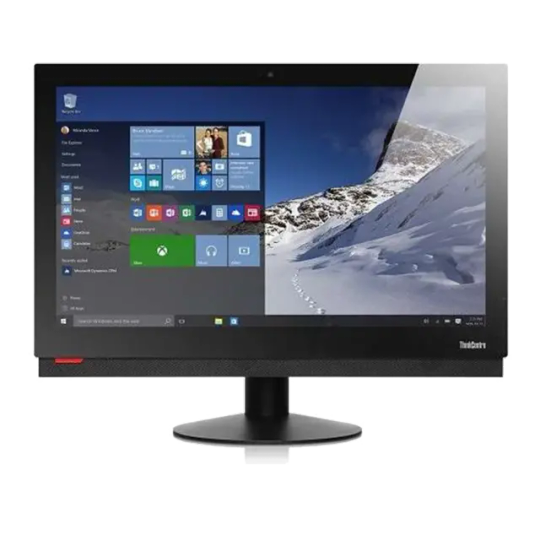
Lenovo ThinkCentre M900z Intel Core i5 6th Gen Stylish. Rugged. Perfect for the Office. The all new M900z AIO comes in a sleek new design that impresses and saves space with its thinner frame. And having passed US military spec testing, it's more rugged than ever. The M900z guarantees powerful performance. Purposefully designed with combined DP in and CP out into one single port you can conveniently switch between laptop, AIO and extended monitor. With other features such as integrated handle for mobility and wide viewing angle, the M900z is an ideal solution for enterprise productivity. Specifications Chassis / Form Factor All-in-one Display / Diagonal Size 23.8 in Display / Diagonal Size (metric) 60.45 cm Display / Native Resolution 1920 x 1080 Display / Type LED Display / Widescreen Display Yes Processor / Chipset Chipset Type: Intel Q170 Clock Speed: 3.2 GHz CPU: Intel Core i5 (6th Gen) 6500 CPU Socket LGA1151 Socket Max Turbo Speed 3.6 GHz Number of Cores Quad-Core Processor Main Features Intel Turbo Boost Technology 2 RAM Configuration Features 8 GB RAM Effective Memory Speed 2133 MHz Features Dual channel memory architecture Form Factor SO-DIMM 260-pin Max: 32 GB Slots 2 (total) / 1 (empty) Technology DDR4 SDRAM Storage Controller Controller Interface Type SATA 6Gb/s Type 1 x SATA Hard Drive / Capacity 500 GB Hard Drive / Interface Serial ATA-600 Networking / Data Link Protocol Bluetooth 4.1 Fast Ethernet Gigabit Ethernet IEEE 802.11a IEEE 802.11ac IEEE 802.11b IEEE 802.11g IEEE 802.11n Networking / Wireless LAN Supported Yes Networking / Wireless Protocol 802.11a/b/g/n/ac Bluetooth 4.1 Optical Storage Optical Storage Type: DVD-Writer Video Output Graphics Processor Intel HD Graphics 530 Audio Output Compliant Standards High-Definition Audio Sound Output Mode Stereo Speakers Included 2 x right / left channel Camera Camera Yes Features Built-in 2 microphones Resolution 1080p Card Reader Type 9 in 1 card reader Expansion / Connectivity Interfaces 6 x USB 3.0 (2 front, 4 rear) 1 x headphones/microphone (1 in front) 1 x DisplayPort input/output combo 1 x LAN (Gigabit Ethernet) General Built-in Devices Stereo speakers Color Business black Embedded Security Trusted Platform Module (TPM 1.2) Security Chip Localization Language: English Platform Technology Intel vPro Platform Product Form Factor All-in-one - with UltraFlex II Stand Graphics Controller Graphics Processor Intel HD Graphics 530 Video Interfaces DisplayPort Input Device Keyboard Interface USB Keyboard Name Preferred Pro USB Localization & Layout US Mouse Interface USB Technology Optical Operating System / Software OS Not provided: Windows 10 Pro 64-bit Edition Power Device Type Power supply Efficiency 85% Power Provided 150 Watt Voltage Required AC 120/230 V (50/60 Hz) No operating system installed
0 notes
Text
Samsung 350watt 2ch Wireless Rear Speakers Kit Swa 8500s/Xa in Ghana
Samsung 350watt 2ch Wireless Rear Speakers Kit Swa 8500s/Xa WIRELESSLY CONNECT 2 REAR SPEAKERS TO COMPATIBLE SAMSUNG SOUNDBARS EASY SETUP FOR A CLUTTER-FREE IMMERSIVE AUDIO EXPERIENCE - POWERFUL BASE - WIRELESS REAR - SPEAKER KIT Sync up to a surround sound experience that doesn’t clutter your space. Link the wireless SWA-9500S Rear Speaker Kit to your Soundbar* without separate modules and enjoy cinematic audio.

Wrapped in sound, not wires

Simple, space-saving setup Full Wireless Solution 360 degree sound Wireless Rear Speaker Connection, with Dolby Atmos Banish the wires and complete your surround sound system by adding wireless rear speakers with Dolby Atmos to your soundbar. Our wireless surround package fits around your space without the need for extra wires to connect to the soundbar. More cinematic and fewer messy wires.

Read the full article
0 notes
Text
SA628F39 8W High Power Full-Duplex Audio Transmission Module
0 notes
Text
Voltage Controlled Oscillators Market: Precision Frequency Control Solutions in Electronics up to 2033
Market Definition The Voltage Controlled Oscillators (VCOs) market encompasses electronic devices that generate oscillating signals with frequencies determined by an input voltage. VCOs are crucial components in various applications, including telecommunications, audio equipment, signal processing, and instrumentation. These devices convert direct current (DC) voltage changes into precise frequency signals, enabling functions such as frequency modulation, phase-locked loops (PLLs), and clock generation. Their versatility and adaptability make them essential in both consumer electronics and industrial applications.
To Know More @ https://www.globalinsightservices.com/reports/Voltage-Controlled-Oscillators-Market
The Voltage Controlled Oscillators market is poised to expand from $4.5 billion in 2023 to $9.2 billion by 2033, with a CAGR of 7.2%, reflecting robust growth.
Market Outlook The Voltage Controlled Oscillators market is anticipated to experience significant growth driven by the increasing demand for high-frequency communication systems, particularly in the telecommunications sector. The rise of 5G networks and the growing need for advanced wireless communication technologies are pushing the demand for VCOs, as they play a key role in frequency synthesis and signal generation. Moreover, the expansion of the Internet of Things (IoT) and connected devices is further enhancing the need for precise timing and frequency control, where VCOs are critical.
Technological advancements in VCO design and fabrication are also contributing to market growth. Innovations such as integrated VCOs, which combine oscillator functions with other circuit elements on a single chip, are improving performance, reducing power consumption, and minimizing size, thus catering to the miniaturization trends in electronic devices. Additionally, the automotive industry’s push towards electric vehicles (EVs) and advanced driver-assistance systems (ADAS) is likely to create new opportunities for VCOs, particularly in radar and communication systems.
Challenges in the market include the potential impact of economic fluctuations on consumer electronics demand and the need for continuous innovation to keep pace with rapid technological advancements. Nevertheless, the increasing focus on connectivity and advanced communication systems, along with the proliferation of smart devices, is expected to drive sustained growth in the Voltage Controlled Oscillators market in the coming years.
Request the sample copy of report @ https://www.globalinsightservices.com/request-sample/GIS31484
0 notes
Link
Check out this listing I just added to my Poshmark closet: BONAOK Karaoke Singing Machine Blue.
0 notes
Text
New Wi-Fi 6E Standard Brings 5G-Related Technologies To Local Area Wireless

In radio, for example, a very narrow band will carry Morse code, a broader band will carry speech, and a still broader band will carry music without losing the high audio frequencies required for realistic sound reproduction. This broad band is often divided into channels or “frequency bins” using passband techniques to allow frequency-division multiplexing instead of sending a higher-quality signal.
In data communications, a 56k modem will transmit a data rate of 56 kilobits per second (kbit/s) over a 4-kilohertz-wide telephone line (narrowband or voiceband). In the late 1980s, the Broadband Integrated Services Digital Network (B-ISDN) used the term to refer to a broad range of bit rates, independent of physical modulation details.
The various forms of digital subscriber line (DSL) services are broadband in the sense that digital information is sent over multiple channels. Each channel is at a higher frequency than the baseband voice channel, so it can support plain old telephone service on a single pair of wires at the same time.
0 notes
Text
Android 14 on Toradex-TI-AM62 Verdin SoM + Dahlia Carrier Board
We are happy to inform you that our engineering team has successfully ported Android 14 onto the Dahlia Carrier Board and the Toradex Verdin AM62 System on Module (SoM), which is powered by Texas Instruments Sitara AM62x processors. Providing a fully functional, ready-to-use Android 14 environment with seamless integration of essential features like HDMI display, touch, Wi-Fi, Bluetooth, audio playback, and OTA updates, this project represents a significant milestone in improving embedded systems for a wide range of applications.

Why Android 14 on Verdin AM62 SoM?
The Verdin AM62 SoM provides the ideal balance between performance and energy efficiency thanks to its affordable yet robust architecture, which is powered by up to four Cortex-A53 cores and the heterogeneous Cortex-M4 for real-time tasks. This SoM is perfect for a variety of use cases, including medical applications, smart cities, industrial automation, and more, thanks to its extensive range of interfaces, which include Ethernet, USB, CAN FD, SPI, I2C, and MIPI camera. The Verdin AM62 SoM's capabilities are increased by Android 14, which offers improved connectivity, security, and performance. We have opened up a world of opportunities for developers who need to use modern operating systems in their embedded projects by successfully porting Android 14.
Key Features Implemented
Our team has gone the extra mile to make this port as user-friendly as possible, including:
Ready-to-Use Flash Image: We have created a simple flash image that uses an installer, so you can quickly install Android 14 on the Verdin AM62 SoM. Even for individuals with less Android porting experience, this makes the entire process easy and accessible.
Fully Working HDMI Display and Touch Support: The port offers a great interface for interactive applications by supporting HDMI displays with touchscreen capabilities.
Wi-Fi and Bluetooth Functionality: This port is perfect for connected IoT applications because we have made sure that wireless connectivity, including dual-band Wi-Fi and Bluetooth 5.2, is fully functional.
Audio and Video Playback: We have seamlessly incorporated both Bluetooth and standard audio playback into the system, offering a dependable media experience. Applications that use a lot of multimedia can benefit from the platform's optimized video playback.
OTA Updates via Update Engine: Using Android's Update Engine to integrate Over-the-Air (OTA) updates is one of this port's most notable features. This implies that devices using this system can get updates remotely, guaranteeing that they stay safe and current without the need for anyone's involvement.
Simplifying Embedded Android Development
As a product design and development partner for Toradex, we’ve leveraged the company's extensive ecosystem, including the Torizon platform for IoT device management. With Torizon’s built-in OTA, remote access, and monitoring capabilities, this Android 14 port makes it easier for developers to manage devices in the field.
The Advantages for Embedded Engineers
This port unlocks opportunities for embedded engineers and developers to explore Android's robust ecosystem in industrial, medical, and IoT applications. The Verdin AM62 SoM’s low-power operation and rich set of interfaces make it highly adaptable to various hardware requirements, while the simplicity of Android's application layer allows rapid development and deployment.
Conclusion
Porting Android 14 on the Toradex Verdin AM62 SoM is a testament to our expertise in embedded systems development. By offering an Android environment that is fully operational and ready for use, we have established a strong foundation for upcoming advancements. Our port of Android 14 makes it easier to develop solutions for connected systems, smart devices, or industrial automation, allowing you to concentrate on what really matters—creating the next generation of intelligent devices.
Are you interested in using Android 14 for your project on the Verdin AM62 SoM? To find out how we can help you on your embedded systems development journey, get in contact with us!
0 notes